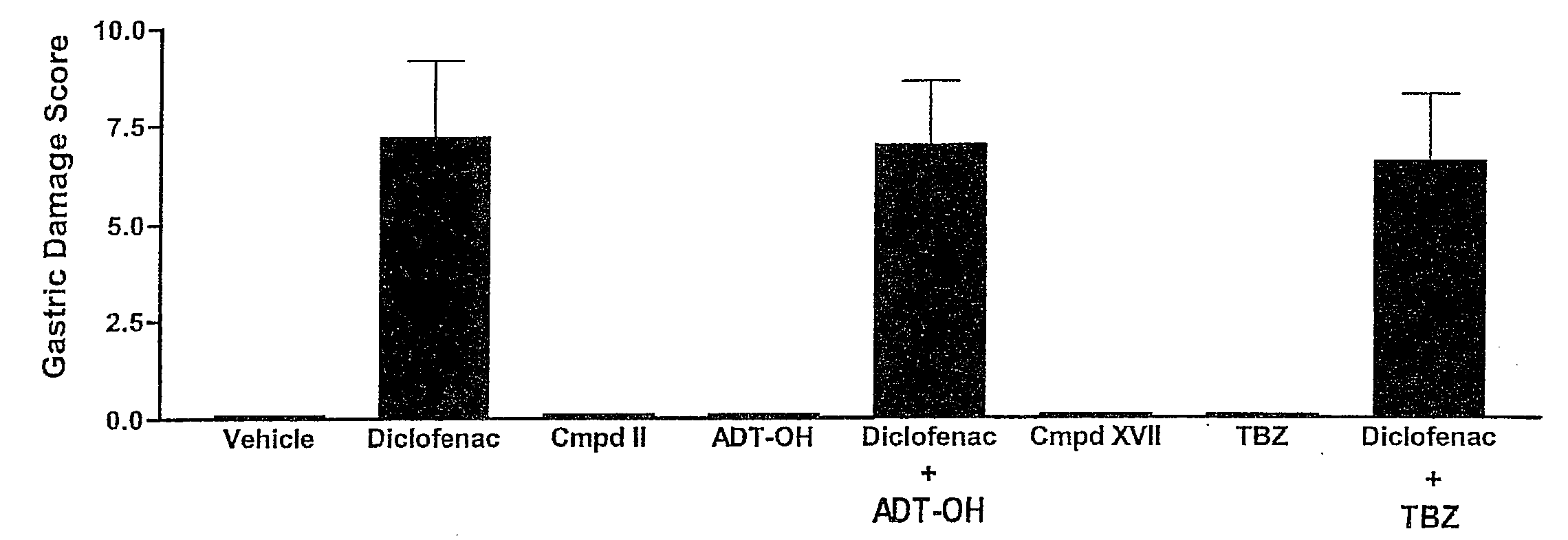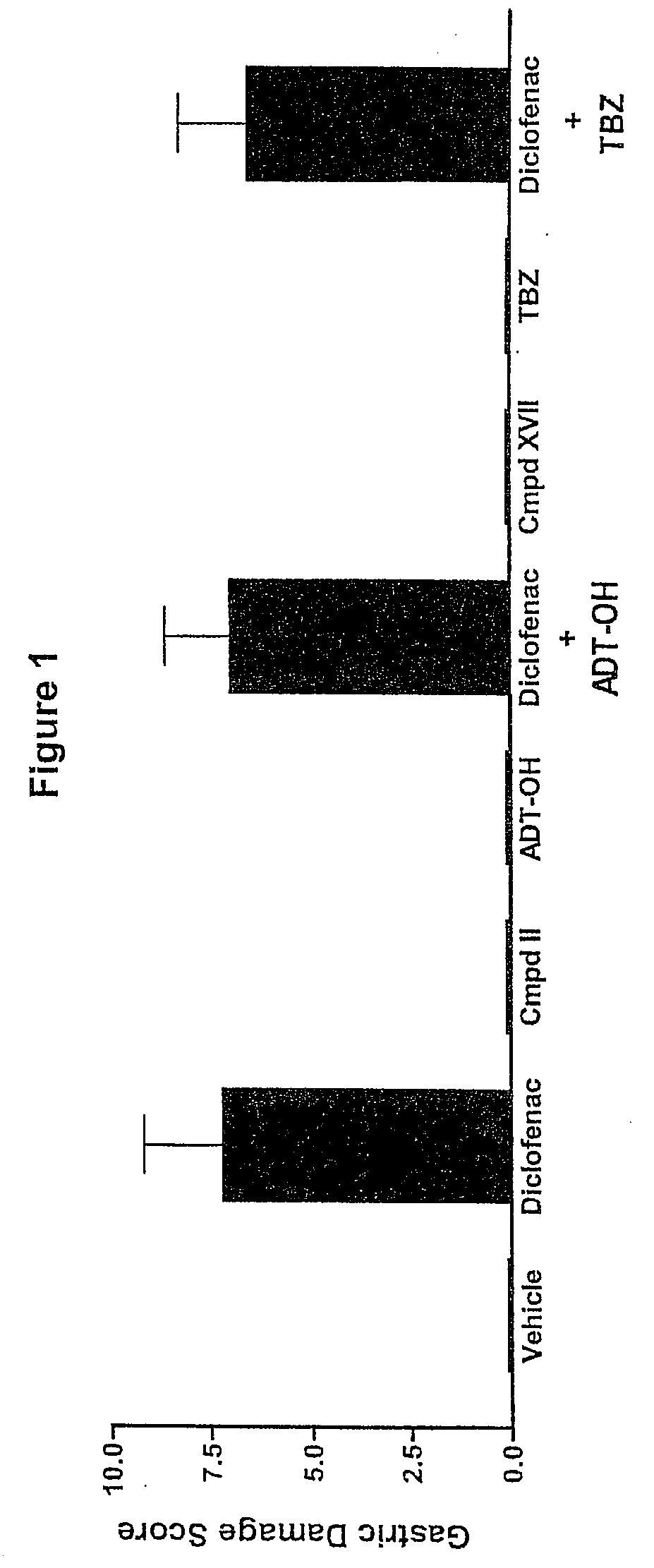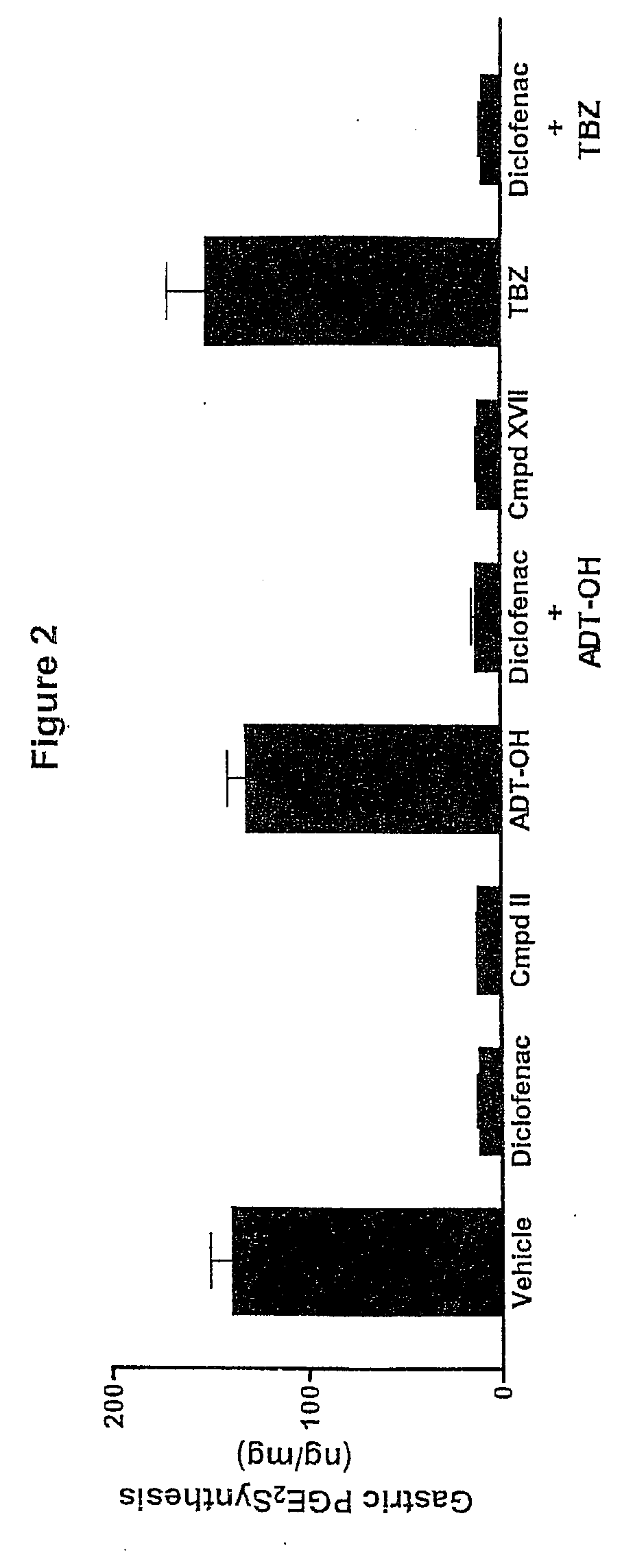Hydrogen sulfide derivatives of non-steroidal Anti-inflammatory drugs
a non-steroidal anti-inflammatory and hydrosulfide technology, applied in the field of derivatives of non-steroidal anti-inflammatory drugs, to achieve the effect of enhancing anti-inflammatory activity and enhancing anti-inflammatory activity
- Summary
- Abstract
- Description
- Claims
- Application Information
AI Technical Summary
Benefits of technology
Problems solved by technology
Method used
Image
Examples
example 1
Synthesis of [2-(2,6-dichloro-phenylamino)-phenyl]-acetic acid 4-(5-thioxo-5H-[1,2]dithiol-3-yl)-phenyl ester (Compound II)
[0055]
Synthesis of 5-p-hydroxyphenyl-1,2-dithiole-3-thione (2; ADT-OH)
[0056]
[0057] Anethole (31 g, 0.21 mol) and sulfur (44.8 g, 1.40 mol) were heated in N,N-dimethylformamide (250 ml) for 8 hrs; after removal of solvent, the residue was almost completely soluble in toluene. An attempt to extract the toluene liquors with 2N-aqueous sodium hydroxide, gave an orange solid precipitate (8.5 g; m.p. over 300° C.). This product was dissolved in boiling water and, after addition of hydrochloric acid, gave 2 as an orange precipitate (6.2 g, yield 13%) m.p. 188-189° C.
[0058]1H NMR (DMSO-d6) δ 6.86 (d, 2H), 7.68 (s, 1H), 7.75 (d, 2H), 10.51 (s, —OH); MS (ESI), m / z 225 (M−).
Synthesis of [2-(2,6-dichloro-phenylamino)-phenyl]-acetic acid 4-(5-thioxo-5H-[1,2]dithiol-3-yl)-phenyl ester (3)
[0059] To the solution of 1 (diclofenac, 890 mg, 3.0 mmol) in 50 mL of N,N-dimethylf...
example 2
Synthesis of [2-(2,6-dichloro-phenylamino)-phenyl]-acetic acid 4-thiocarbamoyl-phenyl ester (Compound XVII)
[0064]
Synthesis of 4-carbamoylphenyl 2-[2-(2,6-dichlorophenylamino)-phenyl]acetate (5)
[0065] To the solution of 1 (diclofenac, 890 mg, 3.0 mmol) in 50 mL of N,N-dimethylformamide, hydroxybenzotriazole (445 mg, 3.3 mmol) and DCC (680 mg, 3.3 mmol) were added with stirring at 0° C. for 1 h. To the reaction mixture 4-hydroxybenzamide (4, 616 mg, 4.5 mmol) was added and stirred for 1 h at 0° C. and 3 hs at room temperature. After filtration, the filtrate was evaporated under reduced pressure and the oily residue thus obtained was dissolved in chloroform; the organic layer was washed with brine, dried on anhydrous MgSO4, filtered and the solvent evaporated. The crude product 5 was loaded on a silica gel open column and eluted with CH2Cl2 / MeOH (9 / 1), from which 4-carbamoylphenyl 2-(2-(2,6-dichlorophenylamino)phenyl)acetate (5) was obtained (212 mg, 17% yield).
Synthesis of [2-(2,6-...
example 3
Synthesis of [2-(2-chloro-6-fluorophenylamino)-phenyl]-acetic acid 4-(5-thioxo-5H-[1,2]dithiol-3-yl)-phenyl ester (Compound III)
[0071]
Synthesis of 4-(5-thioxo-5H-1,2-dithiol-3-yl)phenyl-2-(2-(2-chloro-6-fluorophenylamino)-5-methylphenyl)acetate (3)
[0072] To the solution of 1 (lumiracoxib, 600 mg, 2.03 mmol) in 40 mL of dimethylformamide, hydroxybenzotriazole (301 mg, 2.23 mmol) and DCC (459 mg, 2.23 mmol) were added with stirring at 0° C. for 1 h. To the reaction mixture 5-p-hydroxyphenyl-1,2-dithiole-3-thione (2; 504 mg, 2.23 mmol) was added and stirred for 1 h at 0° C. and 3 h at room temperature. After filtration, the filtrate was evaporated under reduced pressure to remove the solvent. The oily residue thus obtained was dissolved in ethyl acetate; the organic layer was washed with brine, dried on anhydrous MgSO4, filtered and the solvent evaporated. The crude product 3 was loaded on a silica gel open column and eluted with CH2Cl2, from which 4-(5-thioxo-5H-1,2-dithiol-3-yl)phe...
PUM
| Property | Measurement | Unit |
|---|---|---|
| Fraction | aaaaa | aaaaa |
| Molality | aaaaa | aaaaa |
| Molality | aaaaa | aaaaa |
Abstract
Description
Claims
Application Information
 Login to View More
Login to View More - R&D
- Intellectual Property
- Life Sciences
- Materials
- Tech Scout
- Unparalleled Data Quality
- Higher Quality Content
- 60% Fewer Hallucinations
Browse by: Latest US Patents, China's latest patents, Technical Efficacy Thesaurus, Application Domain, Technology Topic, Popular Technical Reports.
© 2025 PatSnap. All rights reserved.Legal|Privacy policy|Modern Slavery Act Transparency Statement|Sitemap|About US| Contact US: help@patsnap.com



